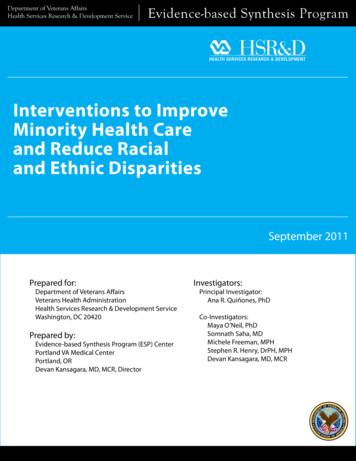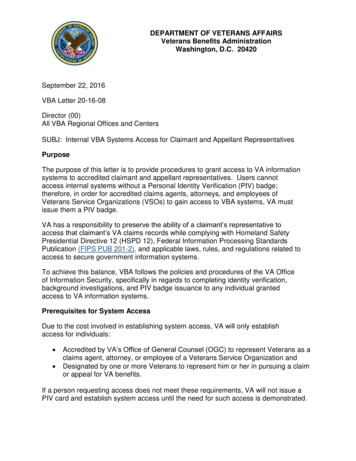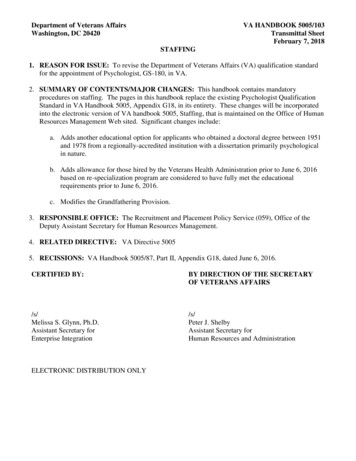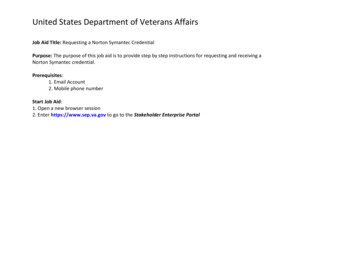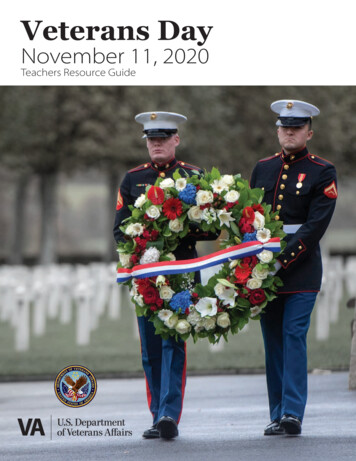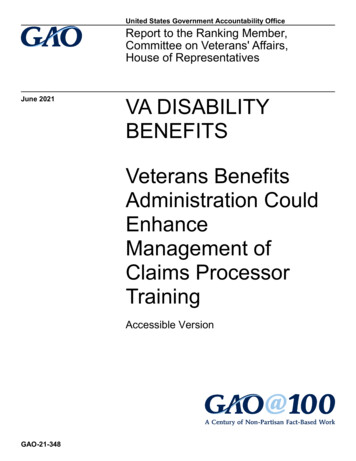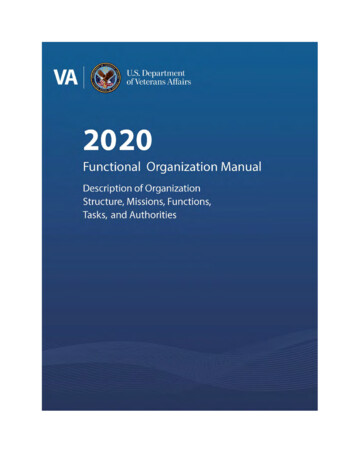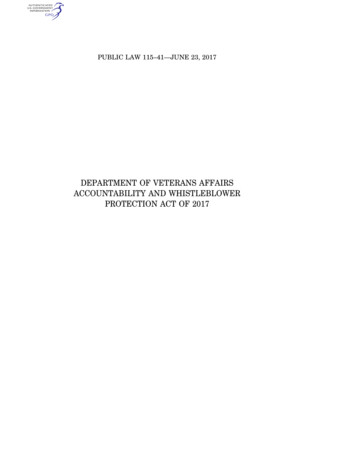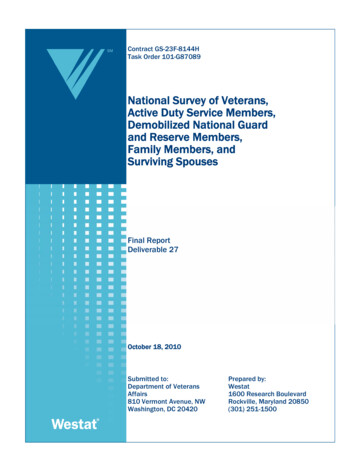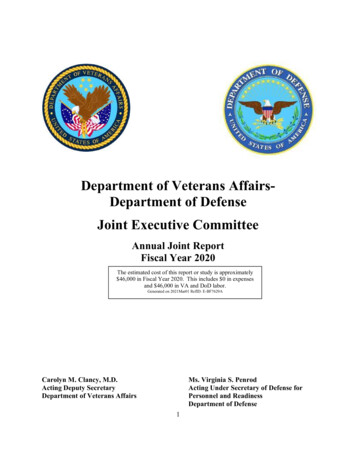
Transcription
Department of Veterans AffairsDepartment of DefenseJoint Executive CommitteeAnnual Joint ReportFiscal Year 2020The estimated cost of this report or study is approximately 46,000 in Fiscal Year 2020. This includes 0 in expensesand 46,000 in VA and DoD labor.Generated on 2021Mar01 RefID: E-BF7629ACarolyn M. Clancy, M.D.Acting Deputy SecretaryDepartment of Veterans AffairsMs. Virginia S. PenrodActing Under Secretary of Defense forPersonnel and ReadinessDepartment of Defense1
VA-DoDJoint Executive CommitteeMembership List(as of September 30, 2020)Department of Veterans AffairsDepartment of DefenseDeputy Secretary of Veterans AffairsAssistant Secretary of the Army forManpower and Reserve AffairsUnder Secretary for HealthUnder Secretary for BenefitsAssistant Secretary of the Navy forManpower and Reserve AffairsAssistant Secretary for Information andTechnologyAssistant Secretary of the Air Force forManpower and Reserve AffairsDeputy Director, Federal Electronic HealthRecord Modernization Program OfficeDeputy Commandant of the Marine Corpsfor Manpower and Reserve AffairsAssistant Secretary for Public andIntergovernmental AffairsExecutive Director, Office of ForceResiliencyAssistant Secretary for Congressional andLegislative AffairsUnder Secretary of Defense for Personneland ReadinessAssistant Secretary for Management andChief Financial OfficerAssistant Secretary of Defense for HealthAffairsPrincipal Executive Director, Office ofAcquisition, Logistics and ConstructionAssistant Secretary of Defense forManpower and Reserve AffairsAssistant Secretary for Human Resourcesand Administration/Operations, Security,and PreparednessPrincipal Deputy Assistant Secretary ofDefense for Health AffairsGeneral Counsel, Office of General CounselOther Invited ParticipantsDepartment of LaborOffice of Management and BudgetDirector, Federal Electronic Health RecordModernization Program OfficeDeputy Assistant Secretary of Defense forHealth Services Policy and OversightDirector, Defense Health AgencyOffice of General CounselExecutive Director, Office of ForceResiliencyDirector, Joint Chiefs of Staff
Department of Defense (continued)Assistant Secretary of Defense, LegislativeAffairsUnder Secretary of Defense (Comptroller)and Chief Financial OfficerAssistant Secretary of Defense, PublicAffairsiii
Table of ContentsSECTION 1 – INTRODUCTION .6SECTION 2 – ACCOMPLISHMENTS .7GOAL 1 – Health Care . 7Objective 1.1. Suicide Prevention . 7Objective 1.2. Individual Longitudinal Exposure Record . 9Objective 1.3. Base Access. 10GOAL 2 – Benefits and Services . 11Objective 2.1. Military-to-Civilian Transition . 11Objective 2.2. Mandatory Separation Health Examinations . 15Objective 2.3. Military Personnel Data Transmission . 16GOAL 3 – Efficiencies of Operation . 18Objective 3.1. Cemetery Transfers . 18Objective 3.2. Movement of Medical Personnel . 19Objective 3.3. VA-DoD Health Care Staffing Services . 20Objective 3.4. Supply Chain Modernization/Defense Medical Logistics Standard Support 21Objective 3.5. Joint Sharing of Facilities and Services . 22GOAL 4 – Interoperability . 23Objective 4.1. Federal Electronic Health Record System Modernization Interoperability . 23Objective 4.2. Integrated Disability Evaluation Bi-directional Case File Transfer Capability. 27Objective 4.3. Joint Architecture . 28Objective 4.4. Identity Management . 29GENERAL OBJECTIVES . 29General Objective 1. Joint Plan to Modernize External Digital Authentication . 29General Objective 2. VA-DoD Reimbursement Process. 30General Objective 3. Credentialing . 31General Objective 4. Telehealth . 32General Objective 5. Military Medical Provider Readiness . 33General Objective 6. Sexual Trauma . 34
Additional Accomplishments . 35Opioid Safety and Awareness. 35Joint Data and Analytics Strategy . 36Patronage Expansion . 37COVID-19 Response . 38VA-DoD Legislative Collaboration. 39SECTION 3 – NEXT STEPS .40Appendix A – Organization .41v
SECTION 1 – INTRODUCTIONThe Department of Veterans Affairs (VA) and Department of Defense (DoD) Joint ExecutiveCommittee is pleased to submit the VA-DoD Joint Executive Committee Fiscal Year (FY) 2020Annual Joint Report, for the period of October 1, 2019 to September 30, 2020, to Congress asrequired by 38 United States Code § 8111(f). The intent of the Annual Joint Report is to provideCongress with information about the collective accomplishments of the two Departments andhighlight current efforts to improve joint coordination and resource sharing. This report does notcontain recommendations for legislation.The Joint Executive Committee provides senior leadership with a forum for collaboration andresource sharing between VA and DoD. In accordance with 38 United States Code § 320, theDeputy Secretary of Veterans Affairs and the Under Secretary of Defense for Personnel andReadiness co-chair the Joint Executive Committee. The Joint Executive Committee consists ofthe leaders of the Health Executive Committee, Benefits Executive Committee, TransitionAssistance Program Executive Council, Information and Technology Executive Committee,Federal Electronic Health Record Modernization Executive Committee1, additional IndependentWorking Groups, and other senior leaders designated by each Department.The Joint Executive Committee works to remove barriers and challenges that impedecollaborative efforts, asserts and supports mutually beneficial opportunities to improve businesspractices, ensures high quality cost-effective services for VA and DoD beneficiaries, andfacilitates opportunities to improve resource utilization. Through a joint strategic planningprocess, the Joint Executive Committee recommends to the Secretaries the strategic direction forjoint coordination and sharing efforts between the two Departments and oversees theimplementation of those efforts.The VA-DoD Joint Executive Committee FY 2020 Annual Joint Report links accomplishmentsto the following four strategic goals established in the VA-DoD Joint Executive Committee JointStrategic Plan FY 2019-2021: (1) Health Care; (2) Benefits and Services; (3) Efficiencies ofOperation; and (4) Interoperability. This approach clarifies the connection between strategicplanning and outcomes achieved through VA and DoD coordination, collaboration, and sharingefforts.The Joint Executive Committee, Health Executive Committee, Benefits Executive Committee,Transition Assistance Program Executive Council, Information and Technology ExecutiveCommittee, Federal Electronic Health Record Modernization Executive Committee, andIndependent Working Groups are comprised of more than 40 Working Groups, Centers ofExcellence, boards, and areas of oversight. See Appendix A for details.1Formerly the Interagency Program Office Executive Committee.6
SECTION 2 – ACCOMPLISHMENTSThis section highlights the FY 2020 accomplishments of the Joint Executive Committee, HealthExecutive Committee, Benefits Executive Committee, Transition Assistance Program ExecutiveCouncil, Information and Technology Executive Committee, Federal Electronic Health RecordModernization Executive Committee, and Independent Working Groups. Theseaccomplishments reflect the efforts of VA and DoD to improve resource sharing between theDepartments and further the mission to optimize the health and well-being of Service members,Veterans, and their eligible beneficiaries. The report also acknowledges some planned activitiesfor FY 2021.GOAL 1 – Health CareProvide a patient-centered health care system that delivers excellent quality, access, satisfaction,and value consistently across the two Departments.Objective 1.1. Suicide PreventionThe VA-DoD-Department of Homeland Security Suicide Prevention Joint Action PlanImplementation Team is an inter-departmental working group that is focused on implementingand tracking the outcomes of the Joint Action Plan for Executive Order 13822, Supporting OurVeterans During Their Transition From Uniformed Service to Civilian Life. In response toExecutive Order 13822, VA, DoD, and the Department of Homeland Security published a planin May 2018 to ensure transitioning Service members and Veterans have seamless access tomental health and suicide prevention resources. Leadership in VA, DoD, and the Department ofHomeland Security oversee the implementation of the plan and report to the Joint ExecutiveCommittee. The VA-DoD Suicide Prevention Joint Action Plan Implementation Team waschartered in December 2018 to continue to provide oversight for Joint Action Plan tasks.The period when Service members separate or retire from the military can include multipleadjustments (e.g., location, career, relationships, family roles, support systems, social networks,community, and financial) and can be a period of increased risk of suicide for some Servicemembers and Veterans. As a result of Executive Order 13822, the Departments continue to worktogether to improve services during transition by doing the following: providing a fullcontinuum of evidence-based mental health care; anticipating and responding to Veteran needs;and supporting all Service members as they reintegrate into their communities as Veterans.The Joint Action Plan initiatives are organized under the following three overarching goals:1) Ensure all transitioning Service members are aware of and have access to mentalhealth resources;2) Ensure the needs of at-risk Veterans are identified and addressed; and3) Improve mental health and suicide prevention services for individuals that have beenidentified in need of care.7
The collaboration between the Departments directly impacts suicide prevention efforts aimed attransitioning Service members, including members of the Reserve and National Guard, UnitedStates Coast Guard, and Veterans. The Joint Action Plan consists of 16 initiatives. At the closeof FY 2020, 15 of these initiatives were complete and the Joint Executive Committee leadershipis tracking metrics to measure impact. The Joint Executive Committee leadership continues totrack progress to completion on the remaining initiative.Activities and milestones accomplished in FY 2020 include the following:Early and Consistent ContactDoD provides VA with Service member contact details and identifies Service members needingpriority contact. VA then conducts outbound calls to all Service members at key intervals afterseparation (e.g., 90-, 180-, 365-days). Specially trained VA representatives utilize activescripting to provide information on access to peer support, availability of mental health care,eligibility for health care and eligibility for VA benefits; a list of available local and nationalresources; and a name and a point of contact for any immediate needs. In addition to calls,Veterans receive information on benefits and eligibility in written format (e.g., email or regularmail). From December 1, 2019 through September 30, 2020, VA contacted 69,980 transitioningService members and Veterans2, which represents an overall contact success rate of 56.6 percentand a 73.4 percent successful contact rate for Priority Veterans3. VA has hired approximately100 specially trained VA representatives to support this effort.Peer SupportDoD, through Military OneSource, implemented peer support outreach to transitioning Servicemembers during the first-year post-separation from the military and a warm hand-off fortransitioning Service members in need of (or requesting) additional psychosocial support tofollow-on peer support services. The outreach effort has resulted in contact with 100 percent oftransitioning Service members that opted-in with valid emails. The goal of the warm hand-offeffort is follow-on peer engagement, within 180 days post-transition, for 90 percent oftransitioning Service members who received a warm hand-off to peer support services. As ofSeptember 30, 2020, 100 percent of transitioning Service members who received a warm handoff to peer support services were connected to peer support. This percentage does not includetransitioning Service members who received referrals to other psychosocial support services,such as non-medical counseling, prior to the warm hand-off process. The process wasformalized at the installation level in June 2020.2Represents unique/initial contacts across all three stages.3For this effort, “Priority Veterans” refers to Veterans identified by DoD who had a mental health care appointmentduring the last year of Active Duty. Additionally, Service members having three or more identified risk factors arefurther stratified.8
Support for Underserved PopulationsThe VA’s Readjustment Counseling Service, in collaboration with DoD’s Psychological HealthCenter of Excellence, developed and implemented a referral process that guides Vet Centercounselors through a referral matrix that includes access to DoD consultation. The collaborationensured that each Vet Center (300) and district leaders were briefed on the referral process. InFY 2020, the Readjustment Counseling Service experienced a 10 percent increase in the numberof Service members seen for military sexual trauma and a 28 percent increase in military sexualtrauma services provided to Service members compared to FY 2019.The Departments continue to collaborate to increase awareness of mental health and suicideprevention resources for all transitioning Service members; expand access to care; and ensure theseamless transition of mental health care for Service members and Veterans. VA and DoD arecommitted to addressing the issue of suicide among Service members and Veterans. As furtherdemonstration of this commitment, the Departments are collaborating with multiple interagencypartners to implement a national public health roadmap, known as the President’s Roadmap toEmpower Veterans and End a National Tragedy of Suicide, in response to Executive Order13861, National Roadmap to Empower Veterans and End Suicide, signed by President Trump onMarch 5, 2019.Objective 1.2. Individual Longitudinal Exposure RecordThe Health Executive Committee’s Deployment Health Working Group continues to jointlydevelop the VA and DoD electronic Individual Longitudinal Exposure Record to captureoccupational and environmental exposures for Service members and Veterans. The IndividualLongitudinal Exposure Record will connect individuals by time, place, event, and all-hazardexposure monitoring data with medical encounter information (diagnosis, treatment, andlaboratory data), across the Service member's career. The Individual Longitudinal ExposureRecord will be available to VA and DoD health care providers, epidemiologists, medicalresearchers, and VA disability evaluation and benefits determination specialists.The Individual Longitudinal Exposure Record technology solution will improve the quality andquantity of information available to facilitate exposure-related health care, assessment ofexposure histories for individuals and populations, disability evaluations, and benefitsdeterminations. The Individual Longitudinal Exposure Record will increase communication andtransparency between VA, DoD, Congress, beneficiaries, and other stakeholders. Finally, thesystem will provide a foundation for prospectively following exposed cohorts for the potentiallong-term or latent health effects that could be attributable to occupational and environmentalexposures.VA and DoD achieved Individual Longitudinal Exposure Record initial operating capabilities onSeptember 30, 2019. In FY 2020, the Departments built on this achievement by completing thefollowing major milestones and activities: connected more than 1.25 million Service membersand Veterans to documented exposures; awarded development contracts and initiated fulloperating capability development; added additional epidemiology functionality to the initialoperating capability; integrated six authoritative data sources with additional data sourcesanticipated; continued to facilitate collaborations across multiple disciplines, and; developed an9
initial roadmap and timeline for integrating the Individual Longitudinal Exposure Record withthe Federal Electronic Health Record System.The team completed multiple Individual Longitudinal Exposure Record version releases,followed by independent system verification and validation testing, with no significant findingsand have maintained a high user approval rating. The team completed an IndividualLongitudinal Exposure Record Initial Operating Capability roll out plan in March 2020 toexpand the Individual Longitudinal Exposure Record user base to a limited “primary audience”that includes a user group from each of the Services’ public health clinical/medical carecommunities and the Defense Health Agency Occupational and Environmental Health Branch.Additional users from specialty clinical/medical care and primary care managers will be addedaccording to the roll out schedule. The number of trained users in VA and DoD has increasedfrom 80 in 2019 to 221 by September 30, 2020. About 2/3 of VA facilities have at least onetrained Individual Longitudinal Exposure Record user as of September 30, 2020. This willapproach 100 percent in early FY 2021. The Individual Longitudinal Exposure Record users arecritical to providing feedback for further development. VA and DoD will continue to worktogether to refine and expand the system to achieve full operating capabilities by September2023.Objective 1.3. Base AccessThe Joint Executive Committee Base Access Working Group was established in 2013 to developand communicate enterprise-wide guidance to ensure VA patients have access to DoDinstallations and facilities that provide health care for Veterans through local sharing agreements.VA and DoD achieved a long-standing and significant goal by establishing consistent enterprisewide DoD installation access standards policy and procedures that consider the needs ofVeterans and their caregivers. On January 2, 2019, DoD published DoD Manual 5200.08,Volume 3, Physical Security Program: Access to DoD Installations. The policy requiresindividuals to provide acceptable credentials to prove identity; fitness for unescorted access; andpurpose for the visit. The policy lists acceptable credentials that will satisfy DoD’s requirementsfor proving identity and purpose for seeking access and includes the Veteran HealthIdentification Card, which is a VA identification card used for enrolled Veterans accessing healthcare containing the Veteran’s picture and a scannable bar code. Fitness is determined by a onetime, on-the-spot check to search for criminal records and terrorism concerns. Veteran HealthIdentification Cards can be enrolled for recurring installation access.The impact of this policy for Veterans is significant because it streamlines previously localizedaccess policies to improve standardization, automates as much of the process as possible toreduce variance, and establishes one-time processes for Veterans to improve efficiency. Theseimprovements effectively balance installation security needs with Veterans’ needs to accessmedical facilities, commissary, exchange, and certain morale, welfare, and recreation retailfacilities on an installation.The Military Departments worked throughout FY 2020 to fully implement the requirements inDoD Manual 5200.08, Volume 3. As of September 30, 2020, approximately 71,000 VeteranHealth Identification Card credentials were enrolled for recurring access. Once a Veteran Health10
Identification Card has been enrolled in DoD’s electronic physical access control system, thecardholder can go directly to the gates of the identity matching engine for security and analysisenabled installations, scan their Veteran Health Identification Card, and be granted accesswithout going into an installation’s Visitor’s Center. As of September 30, 2020, all Navy, AirForce, Marine Corps, and approximately 40 Army installations/bases are identity matchingengine for security and analysis-enabled capable.While VA and DoD efforts have historically been focused on Veterans and caregivers seekingbase access for health care, the Departments expanded efforts in FY 2019 to address Veteransand caregivers seeking other types of benefits. Section 621 of the National DefenseAuthorization Act for FY 2019 authorized the extension of commissary, exchange, and certainmorale, welfare and recreation retail facility privileges to certain Veterans and caregivers. TheBase Access Working Group continues to work closely with the Patronage Expansion WorkingGroup to address installation access requirements for this population. See the AdditionalAccomplishments Section of this report for more details on Patronage Expansion efforts.GOAL 2 – Benefits and ServicesDeliver comprehensive benefits and services through an integrated client-centric approach thatanticipates and addresses client needs.Objective 2.1. Military-to-Civilian TransitionThe Joint Executive Committee approved the Military to Civilian Readiness framework inSeptember 2019. The Military to Civilian Readiness overarching framework establishes thetransition period as the 365 critical days prior to separation through the 365 critical days postseparation and beyond. Military to Civilian Readiness satisfies and builds upon severalcomponents of Executive Order 13822, Supporting our Veterans During Their Transition fromUniformed Service to Civilian Life, as well as the National Defense Authorization Act for FY2019, Sections 522 and 552. The framework includes six steps, across several life domainswhich have been identified as critical to a successful transition for Service members, Veteranstheir families and caregivers:1) Baseline Wellbeing Assessment;2) Transition Assistance process;3) Separation Health Exam process;4) Eligibility for Benefits 30-days prior to separation and an Individualized Statement ofBenefits at Discharge;5) Post separation programs, including expanded Military OneSource access and the VASolid Start Program; and6) Additional post separation touchpoints.11
Military to Civilian Readiness aligns the myriad of transition activities under one overarchingframework and is complementary to current military to civilian support programs, thus providinga more defined exit pathway. The framework ensures that Service members and Veterans: (1)receive comprehensive, standardized, and individualized assessments across both Departments,(2) are informed and educated about all VA and DoD benefits and services they are eligible for,(3) are equipped with the tools they need to succeed and reintegrate into their communities, and(4) achieve sustainable economic well-being. Military to Civilian Readiness providesinteragency support while ensuring a holistic and successful transition. Partners include, but arenot limited to, VA, DoD, and Department of Labor.To meet the congressionally mandated Transition Assistance Program and other mandatorytransition functions, VA, DoD, and Department of Labor, along with other interagency partners,provide a variety of courses, one-on-one engagements and learning opportunities to transitioningService members, Veterans, family members and caregivers. During the first two quarters of FY2020, the VA Benefits and Services course was briefed to over 69,637 transitioning Servicemembers in-person at 237 locations worldwide. The VA Benefits and Services Participant Guidewas recognized with two industry awards from the Association of Marketing andCommunications Professionals. The Participant Guide received Platinum awards in the BenefitsPublication and Program Guide Publication and in the Print Materials category. Additionally, toensure the health and safety of all Transition Assistance Program participants and instructorsduring the COVID-19 pandemic, in-person classes were temporarily halted in March 2020 andTransition Assistance Program shifted to virtual classes during the last two quarters of FY 2020.The Transition Assistance Program curriculum was virtually accessed by 99,308 attendees fromMarch 16 through September 30, 2020.Through FY 2020, 93.8 percent of the transitioning Service members who participated in theTransition Assistance Program, in person, reported having gained valuable information, whichenhanced their confidence in transition. The VA portion of the Transition Assistance Programreceived a 95.8 percent customer satisfaction rating as of the third quarter FY 2020. VA hadmore than 312,651 individual touchpoints to Service members, military spouses, caregivers andsurvivors across all of VA’s transition assistance offerings.To increase an understanding of, and access to, VA and DoD benefits and services, VA ispartnering with DoD to offer nine distinct Military Life Cycle training modules to Servicemembers throughout their military careers and beyond. These modules cover a Servicemember’s journey from initial entry into the military service through separation and the Veteranjourney. In FY 2020, VA delivered 469 Military Life Cycle modules via an instructor-ledclassroom modality, resulting in more than 10,619 touchpoints with Service members, Veteransand their loved ones. Available Military Life Cycle modules include:·Reserve Component Dual Payments;·Social and Emotional Health Resources;·Survivor and Casualty Assistance Resources;·VA Benefits 101;12
·VA Education Benefits;·VA Home Loan Guaranty Program;·VA Life Insurance Benefits;·Vet Centers; and·Community Integration Resources.VA and DoD work together to provide the Women’s Health Transition Training, a transitionresource designed to educate transitioning Service women about available VA health careservices. The Women’s Health Transition Training is designed to improve health outcomesamong women Veterans and enhance connectivity to the VA health care system. The successfulpilot program between the VA and United States Air Force was approved by the Joint ExecutiveCommittee in the fourth quarter of FY 2019 for enterprise-wide expansion. It is projected to beavailable to all transitioning Service women by the end of FY 2021.As part of the pre-separation Military to Civilian Readiness framework, VA and DoD developedthe Baseline Well-Being Assessment. The Transition Assistance Program Executive Councilapproved the Enterprise Individualized Self-Assessment tool as the instrument to meet ExecutiveOrder 13822 and National Defense Authorization Act for FY 2019 requirements to allow forService members to take a self-assessment to ensure they are placed in the appropriate transitionpathway. VA and DoD are working collaboratively on the online platform to host the EnterpriseIndividualized Self-Assessment in development, using a four phased implementation plan, withplanned development complete in September 2021.The Departments are committed to improving the separation exam process to meet therequirements of separating Service members, efficiently, effectively, and with minimumduplication of efforts. In collaboration with subject matter experts throughout VA, DoD, and theServices, the Separation Health Assessment Working Group leads this effort in alignment withthe broader objectives of the Military to Civilian Readiness (see Objective 2.2 for details onSeparation Health
Department of Defense. Joint Executive Committee. Annual Joint Report Fiscal Year 2020. Carolyn M. Clancy, M.D. Acting Deputy Secretary Department of Veterans Affairs. Ms. Virginia S. Penrod Acting Under Secretary of Defense for Personnel and Readiness. Department of Defense. The estimated cost of this report or study is approximately 46,000 .

